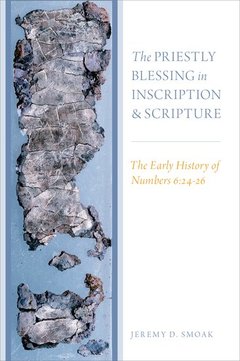The Priestly Blessing in Inscription and Scripture The Early History of Numbers 6:24-26
Langue : Anglais
Auteur : Smoak Jeremy D.

The biblical Priestly Blessing found in Numbers 6:24-26 left a deep imprint upon Jewish and Christian religious practice and tradition. The various ways in which the blessing was incorporated into the liturgical traditions, for example, are well documented in a variety of written sources from the past two thousand years. Rabbinic literature demonstrates that the blessing held a central place in early Jewish traditions, especially as part of the development of the Amidah and other liturgical prayers. Christian tradition also attests to a rich diversity of applications of the blessing in Byzantine and Medieval Christian practice. While the Priestly Blessing's development and significance in Judaism and early Christianity are well documented, considerably less known about its earliest history in the ancient world. The Priestly Blessing in Inscription and Scripture breaks new ground in the study of the origins and early history of the blessing by examining its appearance on two Iron Age amulets discovered at the site of Ketef Hinnom in Jerusalem. Jeremy Smoak provides a comprehensive description of the two amulets and compares the inscriptions on their surfaces with several Phoenician and Punic inscribed amulets. He argues that the blessing's language originated within a wider tradition of protective words, which were often inscribed on metal amulets as protection against evil. He contends that the Priestly writers of the biblical texts incorporated the specific words into the blessing's formulations precisely due to their wide popularity and appeal as protective words in the eastern Mediterranean world. This argument represents an important departure from earlier studies on the background of the blessing's language in the ancient Near East, and it sheds significant new light on the history of their use within early Judaism and Christianity.
Jeremy D. Smoak is a Continuing Lecturer in the Department of Near Eastern Languages and Cultures at UCLA, where he teaches courses in Hebrew Bible, Israelite religions, and ancient Near Eastern literature. His current research focuses on inner-biblical exegesis, prophetic literature, and northwest Semitic inscriptions.
Date de parution : 11-2015
Ouvrage de 264 p.
23.4x15.5 cm
© 2024 LAVOISIER S.A.S.



